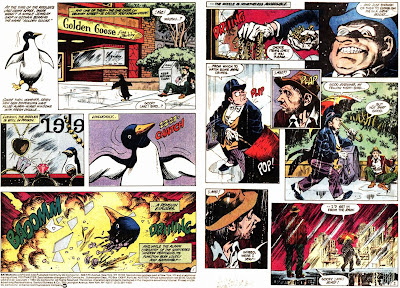Swamp Thing 38-42
“The Curse”
 |
| Before the monsters, there is THE LOVE. |
John Constantine, bastard extraordinaire, has come
dangling answers to Swamp thing's new found existence and 'the truth
behind his super-duper origins!' Too bad to get these truths our pal
Swamp Thing has to play gopher for the British magician and carry out
a couple of sordid tasks before answers will come. Vampires,
werewolves and zombies, oh my.
Saving
himself from death by abandoning his body (plants regrow!)
Swamp Thing inadvertently discovered a plane of existence connecting
all plant life called 'The Green.' Just at this moment British
bastard magician John Constantine arrives offering answers. Almost
like he knew that a certain moss-person would be easy to manipulate
and be useful for mundane tasks; sort of like an unpaid intern.
Constantine has a litany of things he needs done all under the
cryptic guise of stopping an impending doom. That's just not fair,
superheroes can't ignore shit like that. It's like dangling a hot dog
in front of a dog. They're going to bite.
 |
| Feeding on the pale fatty. |
What
is this impending doom? Is it bullshit? No, not bullshit, but as I
said, definitely cryptic. All Swamp Thing knows at this point is what
Constantine tells him and all that Constantine is divulging is that
an ancient evil, something older than Heaven and Hell, has been
hibernating on the shores of creation since before there was a
creation. In advance of this doom, pockets of evil have awakend,
specifically in America. Constantine is the gun, taking aim at these
rising horrors and Swamp Thing will be the bullet he fires.
The
interesting aspect of this story is that the pockets of horror Swamp
Thing is sent to combat are basic horror tropes and situations that
are given different twists so that the familiar, while known, is
neither boring nor stale.
 |
| Swamp Thing fights a baby. And loses. |
Vampires
suck (ho ho ha ha) most of the times and usually they're restricted
to crappy romantic stories or atmospheric (and sometimes still
crappy) Gothic stories. That's not how Swamp Thing rolls here though
because these vampires are the Aquaman of vampires. They reside in a
large man-made lake in the middle of America that just happens to
have been the result of a dam bursting and the tiny village in the
valley submerged. Underwater vampire city (I love comics). Even the
romance angle of vampire stories gets a twisted update in the large
female vampire who's bloated with eggs so much that she bursts in the
town center, spilling her unborn children. The eggs hatch and the
spawn, vampires more evolved to deal with life underwater
(fish-pires?), go on a cannibalistic streak until only one remains:
the strongest, the most evil. It all leads to Swamp Thing versus
giant fish-vampire baby. Not content to rely on fisticuffs in such a
dire situation, Swamp Thing flexes his new plant-powers and creates a
body from a hill just outside the valley and manages to spill the
entire lake down the mountain. Running water kills vampires and so
endeth the threat! Chumps.
 |
| Badass. |
The
second classic horror creature to be remade for the 80s. (how rad)
are werewolves. Instead of just angry men who get hairy on a full
moon, werewolves are a metaphor for gender warfare. Constantine sends
Swamp Thing to a small town where prehistoric human tribes in the
area would send women suffering from the dinosaur-version hysteria.
Basically they buried crazy women alive in a cave. The unknown part
being that the hate and resentment these women rightfully had for the
men who imprisoned them seeped into the earth and festered until an
asshole and his wife moved into a house built on the land. Ancient
evils don't like abusive husbands much like me. So there, something I
have in common with an ancient evil (woooooo). The woman who's
unlucky enough to both live in this house and be beaten by her
husband becomes a vessel for this angry cave-girl rage and is
transformed into a hulking, hair behemoth. In the end, after a
struggle with the Swamp Thing, the woman, overcome with grief with
what she's become, takes her own life before being forced to kill her
piece-of-crap husband. She's a better person than me.
 |
| Domestic violence. |
Finally,
Constantine fires his Swampy bullet towards his hometown of Louisiana
and a horde of zombies that haunt an old plantation and constantly
play out the tragedy that occurred there: a slave revolt turned ugly,
some people were lynched, others flayed alive, and even more still
burnt to death. Ghastly business all around. The creatures are more
ghostly than zombie, but they do have a decayed look and do rise from
graves, so, zombie. Or zhobie. That's not a bad one either.
Regardless of what they end up called, Swamp Thing is able to put an
end to this horror-loop by setting himself on fire and running into
what's left of the old plantation to burn the damn place now. He's
really getting into this whole 'seemingly unkillable' thing. I
respect that.
 |
| Block party! |
Regardless
of Swamp Thing's journey through new versions of the old Universal
monster movies, Constantine stresses that Ancient Ultimate Evil is
still coming and answers to what Swamp Thing is won't be forthcoming
yet, not while there's still business to do. Ah, if Constantine is a
dick, I know everything is alright with the world.




































